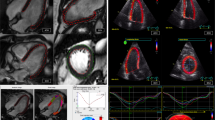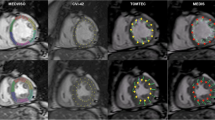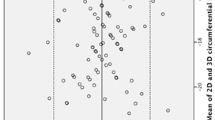Abstract
Objectives
Myocardial deformation integrated with cardiac dimensions provides a comprehensive assessment of cardiac function, which has proven useful to differentiate cardiac pathology from physiological adaptation to situations such as chronic intensive training. Feature tracking (FT) can measure myocardial deformation from cardiac magnetic resonance (CMR) cine sequences; however, its accuracy is not yet fully validated. Our aim was to compare the accuracy and reproducibility of FT with speckle tracking echocardiography (STE) in highly trained endurance athletes.
Methods
Ninety-three endurance athletes (> 12-h training/week during the last 5 years, 52% male, 35 ± 5.1 years old) and 72 age-matched controls underwent resting CMR and transthoracic echocardiography to assess biventricular exercise-induced remodeling and biventricular global longitudinal strain (GLS) by CMR-FT and STE.
Results
Strain values were significantly lower when assessed by CMR-FT compared to STE (p < 0.001), with good reproducibility for the left ventricle (bias = 3.94%, limit of agreement [LOA] = ± 4.27 %) but wider variability for right ventricle strain. Strain values by both techniques proportionally decreased with increasing ventricular volumes, potentially depicting the functional biventricular reserve that characterizes athletes’ hearts.
Conclusions
Biventricular longitudinal strain values were lower when assessed by FT as compared to STE. Both methods were statistically comparable when measuring LV strain but not RV strain. These differences might be justified by the lower in-plane spatial and temporal resolution of FT, which is particularly relevant for the complex anatomy of the RV.
Key Points
• Strain values were significantly lower when assessed by FT as compared to STE, which was expected due to the lower in-plane spatial and temporal resolution of FT versus STE.
• Both methods were statistically comparable when measuring LV strain but not for RV strain analysis.
• Characterizing the normal ranges and reproducibility of strain metrics by FT is an important step toward its clinical applicability, since it can be assessed offline and applied to routinely acquired cine CMR images.



Similar content being viewed by others
Abbreviations
- CMR:
-
Cardiac magnetic resonance
- EDV:
-
End-diastolic volume
- FT:
-
Feature tracking
- GLS:
-
Global longitudinal strain
- LVEF:
-
Left ventricular ejection fraction
- STE:
-
Speckle tracking echocardiography
References
Bijnens BH, Cikes M, Claus P, Sutherland GR (2009) Velocity and deformation imaging for the assessment of myocardial dysfunction. Eur J Echocardiogr 10(2):216–226. https://doi.org/10.1093/ejechocard/jen323
Cikes M, Solomon SD (2016) Beyond ejection fraction: an integrative approach for assessment of cardiac structure and function in heart failure. Eur Heart J 37(21):1642–1650. https://doi.org/10.1093/eurheartj/ehv510
Russo C, Jin Z, Elkind MSV et al (2014) Prevalence and prognostic value of subclinical left ventricular systolic dysfunction by global longitudinal strain in a community-based cohort. Eur J Heart Fail 16(12):1301–1309. https://doi.org/10.1002/ejhf.154
Kalam K, Otahal P, Marwick TH (2014) Prognostic implications of global LV dysfunction: a systematic review and meta-analysis of global longitudinal strain and ejection fraction. Heart 100(21):1673–1680. https://doi.org/10.1136/heartjnl-2014-305538
Pelliccia A, Caselli S, Sharma S et al (2018) European Association of Preventive Cardiology (EAPC) and European Association of Cardiovascular Imaging (EACVI) joint position statement: recommendations for the indication and interpretation of cardiovascular imaging in the evaluation of the athlete’s heart. Eur Heart J 39(21):1949–1969. https://doi.org/10.1093/eurheartj/ehx532
Medvedofsky D, Maffessanti F, Weinert L et al (2018) 2D and 3D echocardiography-derived indices of left ventricular function and shape. JACC Cardiovasc Imaging 11(11):1569–1579. https://doi.org/10.1016/j.jcmg.2017.08.023
Obokata M, Nagata Y, Chien-Chia Wu V et al (2016) Direct comparison of cardiac magnetic resonance feature tracking and 2D/3D echocardiography speckle tracking for evaluation of global left ventricular strain. Eur Heart J Cardiovasc Imaging 17(5):525–532. https://doi.org/10.1093/ehjci/jev227
Onishi T, Saha SK, Delgado-Montero A et al (2015) Global longitudinal strain and global circumferential strain by speckle-tracking echocardiography and feature-tracking cardiac magnetic resonance imaging: comparison with left ventricular ejection fraction. J Am Soc Echocardiogr 28(5):587–596. https://doi.org/10.1016/j.echo.2014.11.018
Pryds K, Larsen AH, Hansen MS et al (2019) Myocardial strain assessed by feature tracking cardiac magnetic resonance in patients with a variety of cardiovascular diseases – a comparison with echocardiography. Sci Rep 9(1):11296. https://doi.org/10.1038/s41598-019-47775-4
Claus P, Omar AMS, Pedrizzetti G, Sengupta PP, Nagel E (2015) Tissue tracking technology for assessing cardiac mechanics. JACC Cardiovasc Imaging 8(12):1444–1460. https://doi.org/10.1016/j.jcmg.2015.11.00
Prior DL, La Gerche A (2012) The athlete’s heart. Heart 98(12):947–955. https://doi.org/10.1136/heartjnl-2011-301329
Caselli S, Di Paolo FM, Pisicchio C et al (2011) Three-dimensional echocardiographic characterization of left ventricular remodeling in olympic athletes. Am J Cardiol 108(1):141–147. https://doi.org/10.1016/j.amjcard.2011.02.350
Pluim BM, Zwinderman AH, van der Laarse A, van der Wall EE (2000) The athlete’s heart: a meta-analysis of cardiac structure and function. Circulation 101(3):336–344. https://doi.org/10.1161/01.cir.101.3.336
Sanz-de la Garza M, Giraldeau G, Marin J et al (2017) Influence of gender on right ventricle adaptation to endurance exercise: an ultrasound two-dimensional speckle-tracking stress study. Eur J Appl Physiol 117(3):389–396. https://doi.org/10.1007/s00421-017-3546-8
Gabrielli L, Bijnens BH, Butakoff C et al (2014) Atrial functional and geometrical remodeling in highly trained male athletes: for better or worse? Eur J Appl Physiol 114(6):1143–1152. https://doi.org/10.1007/s00421-014-2845-6
La Gerche A, Burns AT, D’Hooge J, MacIsaac AI, Heidbüchel H, Prior DL (2012) Exercise strain rate imaging demonstrates normal right ventricular contractile reserve and clarifies ambiguous resting measures in endurance athletes. J Am Soc Echocardiogr 25(3):253–262.e1. https://doi.org/10.1016/j.echo.2011.11.023
Kramer CM, Barkhausen J, Flamm SD, Kim RJ, Nagel E (2013) Standardized cardiovascular magnetic resonance (CMR) protocols 2013 update. Society for Cardiovascular Magnetic Resonance, Board of Trustees Task Force on Standardized Protocols. J Cardiovasc Magn Reson 15(1):91. https://doi.org/10.1186/1532-429X-15-91
Schulz-Menger J, Bluemke DA, Bremerich J et al (2020) Standardized image interpretation and post-processing in cardiovascular magnetic resonance - 2020 update: Society for Cardiovascular Magnetic Resonance (SCMR): Board of Trustees Task Force on Standardized Post-Processing. J Cardiovasc Magn Reson 22(1):19. https://doi.org/10.1186/s12968-020-00610-6
Bland JM, Altman DG (1986) Statistical methods for assessing agreement between two methods of clinical measurement. Lancet Lond Engl 1(8476):307–310
Pedrizzetti G, Claus P, Kilner PJ, Nagel E (2016) Principles of cardiovascular magnetic resonance feature tracking and echocardiographic speckle tracking for informed clinical use. J Cardiovasc Magn Reson 18(1):51. https://doi.org/10.1186/s12968-016-0269-7
Altiok E, Tiemann S, Becker M et al (2014) Myocardial deformation imaging by two-dimensional speckle-tracking echocardiography for prediction of global and segmental functional changes after acute myocardial infarction: a comparison with late gadolinium enhancement cardiac magnetic resonance. J Am Soc Echocardiogr 27(3):249–257. https://doi.org/10.1016/j.echo.2013.11.014
Marwick TH, Leano RL, Brown J et al (2009) Myocardial strain measurement with 2-dimensional speckle-tracking echocardiography. JACC Cardiovasc Imaging 2(1):80–84. https://doi.org/10.1016/j.jcmg.2007.12.007
Scatteia A, Baritussio A, Bucciarelli-Ducci C (2017) Strain imaging using cardiac magnetic resonance. Heart Fail Rev 22(4):465–476. https://doi.org/10.1007/s10741-017-9621-8
Taylor RJ, Moody WE, Umar F et al (2015) Myocardial strain measurement with feature-tracking cardiovascular magnetic resonance: normal values. Eur Heart J Cardiovasc Imaging 16(8):871–881. https://doi.org/10.1093/ehjci/jev006
Morais P, Marchi A, Bogaert JA et al (2017) Cardiovascular magnetic resonance myocardial feature tracking using a non-rigid, elastic image registration algorithm: assessment of variability in a real-life clinical setting. J Cardiovasc Magn Reson 19(1):24. https://doi.org/10.1186/s12968-017-0333-y
Andre F, Steen H, Matheis P et al (2015) Age- and gender-related normal left ventricular deformation assessed by cardiovascular magnetic resonance feature tracking. J Cardiovasc Magn Reson 17(1):25. https://doi.org/10.1186/s12968-015-0123-3
Augustine D, Lewandowski AJ, Lazdam M et al (2013) Global and regional left ventricular myocardial deformation measures by magnetic resonance feature tracking in healthy volunteers: comparison with tagging and relevance of gender. J Cardiovasc Magn Reson 15:8. https://doi.org/10.1186/1532-429X-15-8
Amaki M, Savino J, Ain DL et al (2014) Diagnostic concordance of echocardiography and cardiac magnetic resonance-based tissue tracking for differentiating constrictive pericarditis from restrictive cardiomyopathy. Circ Cardiovasc Imaging 7(5):819–827. https://doi.org/10.1161/CIRCIMAGING.114.002103
Orwat S, Kempny A, Diller G-P et al (2014) Cardiac magnetic resonance feature tracking: a novel method to assess myocardial strain. Comparison with echocardiographic speckle tracking in healthy volunteers and in patients with left ventricular hypertrophy. Kardiol Pol 72(4):363–371. https://doi.org/10.5603/KP.a2013.0319
Padiyath A, Gribben P, Abraham JR et al (2013) Echocardiography and cardiac magnetic resonance-based feature tracking in the assessment of myocardial mechanics in tetralogy of Fallot: an intermodality comparison. Echocardiogr Mt Kisco N 30(2):203–210. https://doi.org/10.1111/echo.12016
Taha K, Bourfiss M, te Riele ASJM et al (2020) A head-to-head comparison of speckle tracking echocardiography and feature tracking cardiovascular magnetic resonance imaging in right ventricular deformation. Eur Heart J Cardiovasc Imaging. https://doi.org/10.1093/ehjci/jeaa088
Funding
This work was partially funded by grants from AGAUR (M. Sanz-de la Garza, MD, PhD), Plan Nacional I. D, Del Programa Estatal de Fomento De La Investigación Científica y Técnica de Excelencia, Subprograma De Generación Del Conocimiento, Ministerio de Economía y Competitividad 2013 (grant number DEP2013–44923-P).
Author information
Authors and Affiliations
Corresponding author
Ethics declarations
Guarantor
The scientific guarantor of this publication is Marta Sitges, MD, PhD.
Conflict of interest
The authors of this manuscript declare no relationships with any companies, whose products or services may be related to the subject matter of the article.
Statistics and biometry
One of the authors has significant statistical expertise.
Informed consent
Written informed consent was obtained from all subjects (patients) in this study.
Written informed consent was waived by the Institutional Review Board.
Ethical approval
Institutional Review Board approval was obtained.
Study subjects or cohorts overlap
Some study subjects or cohorts have been previously reported in other papers but always with different objectives, in: Domenech-Ximenos, et al Journal of Cardiovascular Magnetic Resonance (2020) 22:62, Domenech-Ximenos, et al Eur J Prev Cardiol 2020 Apr, and M. Sanz-de la Garza, et al Eur J Prev Cardiol 2020 Sep.
Methodology
• prospective
• observational
• performed at one institution
Additional information
Publisher’s note
Springer Nature remains neutral with regard to jurisdictional claims in published maps and institutional affiliations.
Rights and permissions
About this article
Cite this article
Domenech-Ximenos, B., Sanz-de la Garza, M., Sepulveda-Martinez, Á. et al. Assessment of myocardial deformation with CMR: a comparison with ultrasound speckle tracking. Eur Radiol 31, 7242–7250 (2021). https://doi.org/10.1007/s00330-021-07857-2
Received:
Revised:
Accepted:
Published:
Issue Date:
DOI: https://doi.org/10.1007/s00330-021-07857-2




